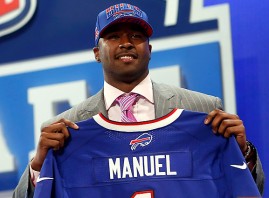2013 NFL Draft Observations
Added on Apr 28, 2013 by Scott in

Unlike 2012, the 2013 NFL Draft lacked the starpower of Andrew Luck, RG III, Trent Richardson, Justin Blackmon and Morris Claiborne. Instead of dynamic skill positions, this year’s crop of prospects was dominated by lineman on both sides of the ball. While the significance of each team’s selections won’t be known for at least a couple more years, it’s always fun to assess how certain teams approached the three-day process. Here are some initial observations.
Dolphins take another risk – Miami GM Jeff Ireland entered the offseason knowing he had to dramatically improve his roster or his job was in jeopardy. After shelling out big money for Mike Wallace, Philip Wheeler and Dannell Ellerbe in free agency, Ireland jumped nine spots to nab Oregon OLB Dion Jordan, a raw talent who totaled 14.5 sacks in three seasons. By contrast, Pittsburgh sat and waited for Georgia’s Jarvis Jones to fall to them at 17. Jones, a more disruptive and polished pass rusher than Jordan, notched 14.5 sacks and seven forced fumbles just in 2012. Time will tell if Miami backed the right guy.
Bengals add punch – Cincinnati needed offensive help and succeeded with their first two picks. Tight end Tyler Eifert and running back Giovani Bernard are difference makers who should alleviate pressure from quarterback Andy Dalton and wide receiver A.J. Green. To compete with the AFC’s elite, the Bengals must find a way to score more points in the playoffs. The hope is Eifert and Bernard will be enough to level the playing field.
The Purple problem – The consensus is the Vikings scored huge with their trio of first-rounders, Sharrif Floyd, Xavier Rhodes and Cordarrelle Patterson. This is probably true, but they still have Christian Ponder under center, and until he takes another step toward elite status, Minnesota will remain a notch below Green Bay, Atlanta, San Francisco and Seattle. Adrian Peterson is a machine, but he won’t be around forever.
Manuel magic? – Buffalo rolled the biggest pair of dice when they traded back and took the first quarterback off the board, Florida State’s E.J. Manuel. The ex-Seminole is big, athletic and possesses a solid football acumen. However, a lack of dominating performances and a tendency to fold in spotlight games is the reason most pundits had him graded as a second-round talent at best. The Bills better cross their fingers Robert Woods pans out and C.J. Spiller stays healthy, because counting on Manuel to be a franchise signal-caller with a weak set of playmakers is foolish.
Same ol’ Boys – Leave it to Jerry Jones and son Stephen to make draft headlines for all the wrong reasons. The bumbling duo grabbed center Travis Frederick at pick #31, even though every “expert” had him graded as a third-round prospect. Then, father and son ignored tackle altogether and waited until the sixth-round before adding another running back, Oklahoma State’s Joseph Randle. It’s no wonder this team underachieves every single season.
Chip Ahoy! – Based on what Eagles head coach Chip Kelly has done in free agency and the draft, it appears he might be leaning toward an offensive scheme that resembles the Patriots, not his read-option Ducks teams. Michael Vick is still his best option to start the season, but the addition of tight ends James Casey and Zach Ertz, as well as quarterback Matt Barkley, lends credence to the notion that Kelly will attempt at some point to use a drop back passer to trigger his up-tempo attack. Easier said than done, especially without Tom Brady.
Green Bay balance – GM Ted Thompson wisely bolstered his lackluster backfield by adding Alabama’s Eddie Lacy and UCLA’s Johnathan Franklin. Aaron Rodgers can sling it better than anyone, but balancing out a pass heavy attack is vital to the Pack’s Super Bowl aspirations.
Jets mess – Geno Smith, really? The Mark Sanchez and Tim Tebow experiments were unmitigated disasters. So why not bring in a quarterback who plummeted down draft boards to solve their signal-caller woes? Makes perfect sense, right?





















